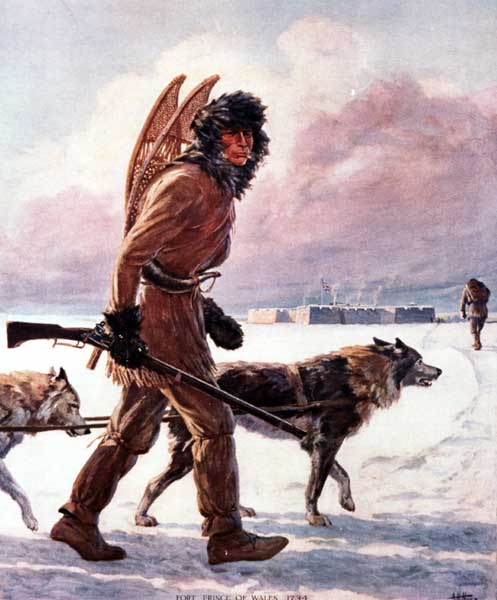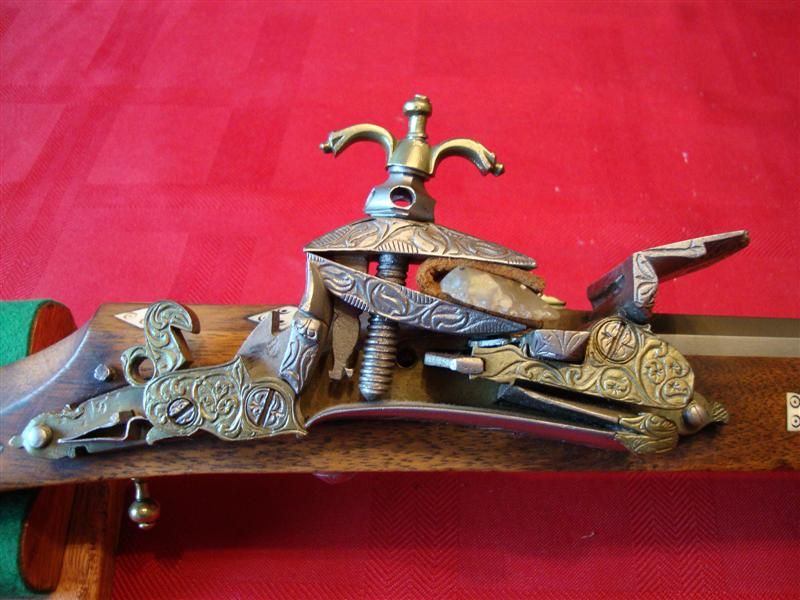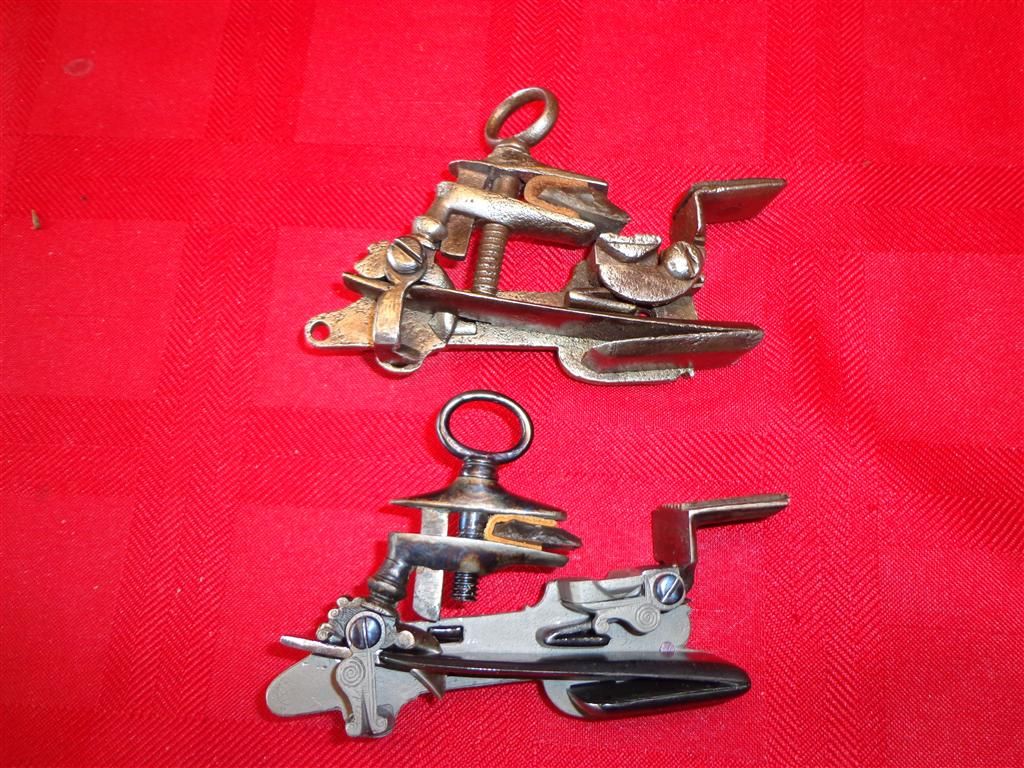It's 1922 Hudson's Bay calendar art to be exact - done by Arthur H. Hider. It shows a Chipewyan Indian carrying a Spanish Miquelet long gun. The painting has great detail. The gun is shown in full detail, as well as the Indian's powder horn and attire. Hider must have had done some research on weapons used by the natives at these Northern latitudes to have depicted this particular gun. I do know that an early form of Miquelet type lock called an Agujeta has shown up on an Iroquois site and one complete lock at the Martins Hundred site near Jamestown. Some remains of these Agujeta locks have also been found in Spanish settlements in Florida. I'm working on a post specific to this difference between the 2 styles but still struggling with the text. Anyway, to see the painting go to: WWW.mhs.mb.ca and enter in the search field: Fort Prince of Wales, 1734 - then click on Manitoba History: The Life and Death of Matonabbee: Fur Trade to see the picture. G.S.
-
This community needs YOUR help today. We rely 100% on Supporting Memberships to fund our efforts. With the ever increasing fees of everything, we need help. We need more Supporting Members, today. Please invest back into this community. I will ship a few decals too in addition to all the account perks you get.

Sign up here: https://www.muzzleloadingforum.com/account/upgrades -
Friends, our 2nd Amendment rights are always under attack and the NRA has been a constant for decades in helping fight that fight.
We have partnered with the NRA to offer you a discount on membership and Muzzleloading Forum gets a small percentage too of each membership, so you are supporting both the NRA and us.
Use this link to sign up please; https://membership.nra.org/recruiters/join/XR045103
You are using an out of date browser. It may not display this or other websites correctly.
You should upgrade or use an alternative browser.
You should upgrade or use an alternative browser.
Miquelet Escopeta in a painting
- Thread starter krolick
- Start date

Help Support Muzzleloading Forum:
This site may earn a commission from merchant affiliate
links, including eBay, Amazon, and others.
Or :wink:Gulielmus Smith said:Anyway, to see the painting go to: WWW.mhs.mb.ca and enter in the search field: Fort Prince of Wales, 1734 - then click on Manitoba History: The Life and Death of Matonabbee: Fur Trade to see the picture.

I wonder if the painter was using a random old gun that he didn't know the history of, and didn't know it was a Spanish piece; or was this a meusem piece from HBC collection that did have a history with Canada/old northwest.
Fernando Keilty
36 Cal.
- Joined
- Mar 10, 2012
- Messages
- 66
- Reaction score
- 7
/home/fernando/IMG_0405.JPG
Fernando Keilty
36 Cal.
- Joined
- Mar 10, 2012
- Messages
- 66
- Reaction score
- 7
Fernando Keilty
36 Cal.
- Joined
- Mar 10, 2012
- Messages
- 66
- Reaction score
- 7
Fernando Keilty
36 Cal.
- Joined
- Mar 10, 2012
- Messages
- 66
- Reaction score
- 7
Fernando Keilty
36 Cal.
- Joined
- Mar 10, 2012
- Messages
- 66
- Reaction score
- 7
hi
The painting, despite the intention of the painter, not allow s see clearly, but I think I see the safety catch (dog) and I think the frizzen spring is double, as in the classic miguelete.
The lace lock is distinguished from its Evolucio, the lock of miguelete because the average riding (half-cock) is achieved through uun safety hook manually moved and retracted by a spring when fully assembled mechanism (full-cock )
In the classic postures migueleta half cock and full cock are achieved through the pin, riding in the chocks.
In the lock of lace have been few examples, but the lock "to morlacca" is a copy, with Arabic decoration.
Deputy reproduction of a photograph of the morlacca lock and a key Spanish transition that have the same characteristics.
Affectionately. K. Fernando Perrdon by the translator and disadvantages to computation.
The painting, despite the intention of the painter, not allow s see clearly, but I think I see the safety catch (dog) and I think the frizzen spring is double, as in the classic miguelete.
The lace lock is distinguished from its Evolucio, the lock of miguelete because the average riding (half-cock) is achieved through uun safety hook manually moved and retracted by a spring when fully assembled mechanism (full-cock )
In the classic postures migueleta half cock and full cock are achieved through the pin, riding in the chocks.
In the lock of lace have been few examples, but the lock "to morlacca" is a copy, with Arabic decoration.
Deputy reproduction of a photograph of the morlacca lock and a key Spanish transition that have the same characteristics.
Affectionately. K. Fernando Perrdon by the translator and disadvantages to computation.
- Joined
- May 24, 2005
- Messages
- 4,960
- Reaction score
- 4,327
Hello all. Very cool painting. Never seen that one. I'll save it in my library. Thanks for Posting.
Here is a closer look at the early style of miquelet lock that Fernando was posting. Notice the dog-style manual safety and the mainspring operating off the toe of the hammer. This is from an Algerian gun.
The second photo shows a copy of a 1650's style Spanish lock from TRS with a very similar original lock just above it. Notice the sear provision for both half and full cock, with the mainspring operating on the heel of the hammer.
Just for comparision. Rick. :hatsoff:


Here is a closer look at the early style of miquelet lock that Fernando was posting. Notice the dog-style manual safety and the mainspring operating off the toe of the hammer. This is from an Algerian gun.
The second photo shows a copy of a 1650's style Spanish lock from TRS with a very similar original lock just above it. Notice the sear provision for both half and full cock, with the mainspring operating on the heel of the hammer.
Just for comparision. Rick. :hatsoff:


Ken Cormier
50 Cal.
- Joined
- Nov 9, 2010
- Messages
- 1,325
- Reaction score
- 2
Thanks to all for posting. A really neat read. Thanks again. L :hatsoff:








